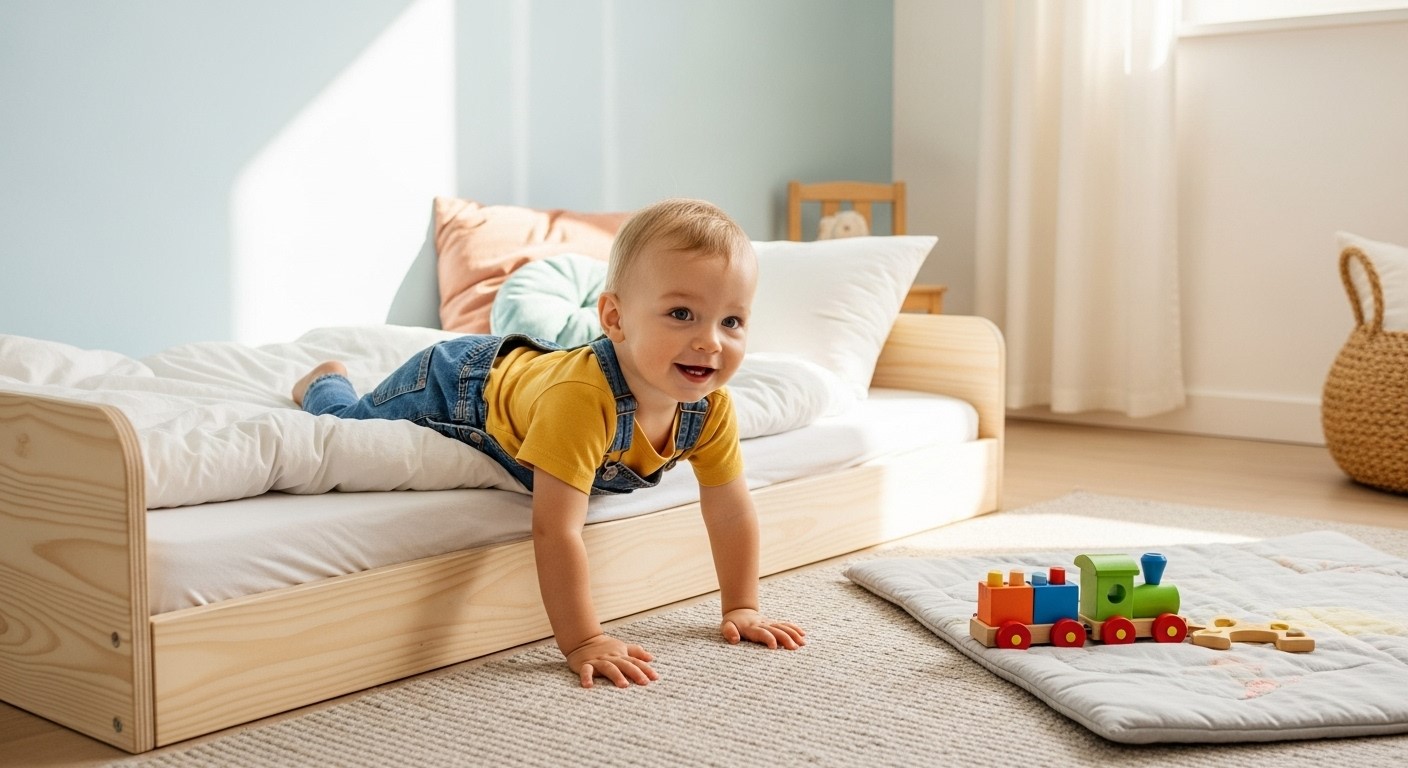The Montessori Infant Bed: Unlock Your Child’s Independence (The Ultimate Guide)
Ever peek into your nursery and see your baby awake in their crib, staring at the ceiling, simply waiting for you to decide their day can begin?
It’s a familiar scene for many parents—a quiet, contained world defined by wooden bars.
But what if their environment could offer them agency, freedom, and a deep sense of trust from the very beginning?
You’ve likely heard whispers of the Montessori Infant Bed, and you’re wondering if this radically simple, floor-level bed is the key to a more independent, peaceful, and developmentally-rich environment for your child.
You want to know if it’s safe, when to start, and if it truly makes a difference.
You’re in the right place. This comprehensive guide will walk you through everything you need to know, from the core philosophy to the non-negotiable safety rules.
By the end, you’ll have the clarity and confidence to decide if this approach is the perfect fit for your family.
What Exactly Is a Montessori Infant Bed?
First, let’s clear up a common misconception. A Montessori infant bed isn’t a specific brand you buy.
It’s a concept: a firm, child-safe mattress placed directly on the floor or on a very low, slat-less frame.
Unlike a traditional crib, which contains a child, a floor bed provides unobstructed freedom of movement.
It is the cornerstone of a nursery designed around respect for the child as a capable individual.
The “why” behind this is profound. Dr. Maria Montessori believed that a child’s environment should be a “prepared environment”—one that is carefully designed to foster autonomy and natural development.
A crib, in this view, is a beautiful cage. A floor bed, on the other hand, tells your child, “I trust you.
You can listen to your body’s needs. You are free to explore your safe space when you are awake.”
The Transformative Benefits of a Floor Bed
Switching to a floor bed is more than an interior design choice; it’s a shift in parenting philosophy that can have a lasting impact on your child’s development.
Fostering Independence and Autonomy
This is the most celebrated benefit. When a baby wakes up, they aren’t trapped.
They can choose to roll off their mattress and engage with a safe toy, look out the window, or simply explore their room.
This small act of freedom builds a powerful foundation for decision-making and self-reliance.
Building Body Awareness and Motor Skills
Navigating getting on and off the mattress is a mini-gymnastics routine for an infant.
It helps them master gross motor skills, understand their physical boundaries, and develop spatial awareness far earlier than if they were simply lifted in and out of a crib.
Promoting a Positive Relationship with Sleep
Many parents report that a floor bed removes the power struggle around bedtime.
The bed isn’t a place of confinement they are put into, but a comfortable space they can go to.
It helps them learn to recognize their own sleep cues and go to their bed when they feel tired, fostering a lifelong healthy relationship with sleep.
Simplifying the Nursery Environment
A floor bed encourages a minimalist approach. Since the room must be completely baby-proofed, it naturally leads to less clutter and more intentional choices about what is accessible to the child.
This creates a calming, beautiful, and functional space.
“The child’s environment should be a living one, not a museum of things that are not to be touched.” – [Quote from a certified Montessori guide or Dr. Maria Montessori’s writings]
Is Your Child Ready? When to Start Using a Floor Bed
There is no magic age, but rather a focus on developmental readiness and family comfort. Here are the most common approaches:
- From Birth: Some families start from day one, often with the mattress right next to the parents’ bed. This requires diligent adherence to safe sleep practices for newborns.
- When Rolling/Crawling (4-8 Months): This is the most popular time to introduce a floor bed for baby. Once a child is mobile, the bed’s freedom becomes immediately useful. They have the motor skills to safely get on and off the mattress.
- Transitioning from a Crib (1-2 Years): Many families make the switch when their child starts climbing out of the crib or shows frustration with being confined.
Key takeaway: The decision should be based on your child’s mobility and your ability to create a 100% safe room, not a number on a calendar.
The Non-Negotiable Guide to Floor Bed Safety
Freedom for a child requires absolute diligence from the parent.
A Montessori bedroom is not just a room with a mattress on the floor; it is a completely baby-proofed sanctuary.
Your Floor Bed Safety Checklist:
- The Room IS the Crib: This is the most important mindset shift. Every single inch of the room must be as safe as an empty crib.
- Secure All Furniture: All dressers, shelves, and heavy objects must be securely anchored to the wall. No exceptions.
- Cover All Outlets: Every electrical outlet must have a secure cover. Cords from lamps, monitors, and sound machines must be completely out of reach and secured.
- Remove Hazards: There should be no small objects, plastic bags, choking hazards, or long strings (like blind cords) anywhere in the room.
- Firm Mattress, No Gaps: Use a firm infant or toddler mattress. Ensure there are no gaps between the mattress and the walls where a baby could get trapped.
- No Soft Bedding: Following safe sleep guidelines is paramount. The mattress should have only a tight-fitted sheet. No pillows, heavy blankets, or stuffed animals on the sleep surface for infants.
For the most up-to-date recommendations, always consult the safe sleep guidelines provided by the American Academy of Pediatrics (AAP). [Cite American Academy of Pediatrics (AAP) safe sleep guidelines]
Creating the Perfect Montessori Bedroom Setup
The bed is just one piece of the puzzle. To truly embrace the philosophy, consider the entire Montessori bedroom setup.
- Low, Accessible Shelving: Place a few age-appropriate toys and books on low shelves your child can reach independently.
- Child-Sized Furniture: A small table and chair, a low-hanging mirror, or a small wardrobe with a few clothing choices empower your child to interact with their world.
- Rotate Toys: Avoid overwhelming your child. Offer a small selection of 5-8 toys and rotate them weekly to maintain interest and encourage deep focus.
- A Calm Atmosphere: Use neutral colors, natural materials, and soft lighting to create a peaceful environment that promotes concentration and rest.
Expert Tips for a Smooth Transition from Crib to Floor Bed
Worried about the change? It’s often harder for the parent than the child!
- Start with Naps: Introduce the floor bed for naps first. This is a lower-pressure way for both of you to get used to the new freedom.
- Keep the Routine Consistent: Your soothing bedtime routine (bath, books, songs) is more important than ever. Perform the routine as usual, but end with a cuddle on the new mattress.
- Stay Calm and Patient: The first few nights, your child might explore. They might roll off the bed. This is normal! Calmly and quietly guide them back to their mattress. Your calm presence teaches them that this new space is safe for sleep.
- Embrace the “False Start”: If they get up to play, don’t engage. The room should be dark and boring. They will quickly learn that nighttime is for sleeping, and their freedom is for when they wake up in the morning.
Frequently Asked Questions about the Montessori Infant Bed
1. What if my baby just crawls out and plays all night?
This is the number one fear, but it’s rare for it to be a long-term problem. Initially, the novelty might lead to exploration.
By keeping the room dark and unstimulating and consistently returning them to bed with minimal interaction, they learn that nighttime is for rest.
2. Do I need to buy a special “Montessori” branded bed frame?
Absolutely not. The simplest and most authentic Montessori infant bed is a firm mattress directly on the floor.
Low wooden frames are an aesthetic choice but are not necessary. The key is low height and accessibility.
3. How do I handle naps in a floor bed?
The same way you handle nighttime sleep. A consistent pre-nap routine helps signal that it’s time for rest.
The freedom to get up when they are truly done napping can often lead to happier, better-rested children.
4. Is a floor bed safe for a newborn?
It can be, but it requires extreme diligence. The baby must be placed on their back on a firm surface with no soft bedding, and the room must be 100% hazard-free.
Many parents prefer a co-sleeper bassinet for the first few months before transitioning to the floor bed.
Your Journey to Fostering Independence Starts Now
Choosing a bed for your child is about more than where they will sleep. It’s a reflection of your parenting values.
The Montessori infant bed is not just a piece of furniture; it is a tool that empowers your child, builds their confidence, and places trust at the heart of their environment.
You are now equipped with the philosophy, the practical steps, and the safety knowledge to decide if a floor bed is the right choice for your family.
Trust your instincts, prioritize safety above all else, and embrace the beautiful journey of watching your child explore their world with newfound confidence and independence.

